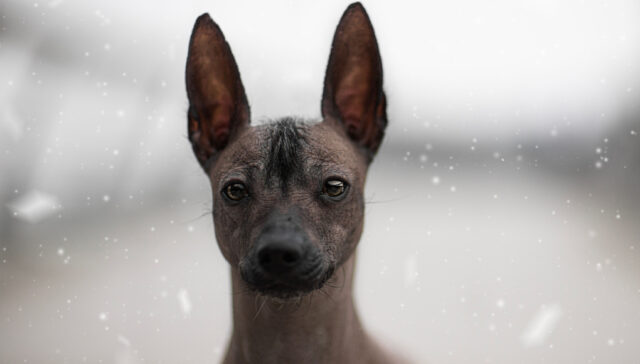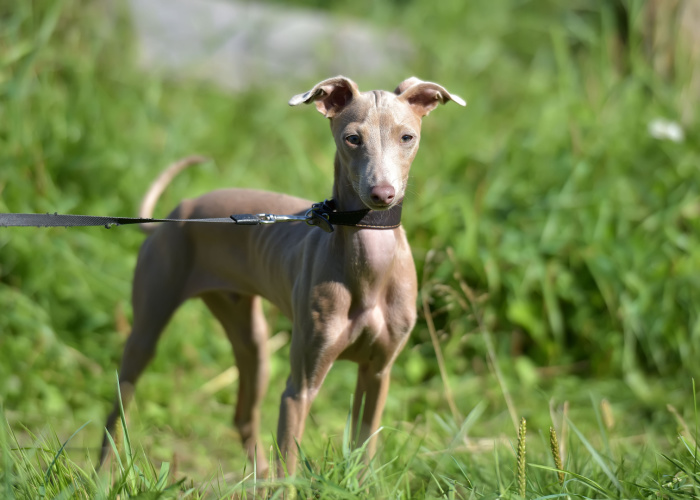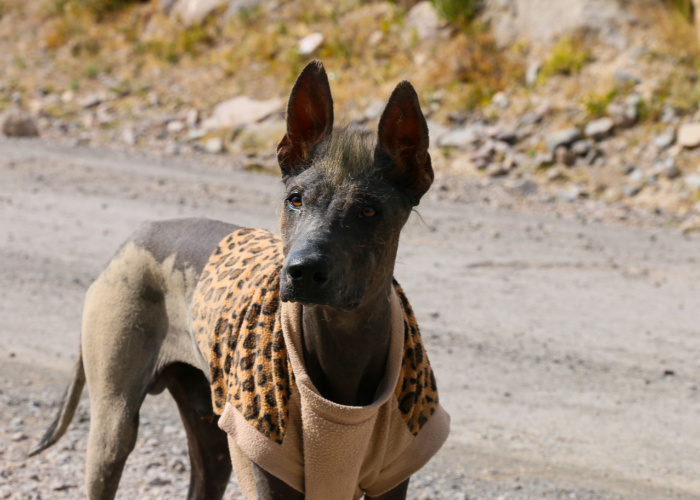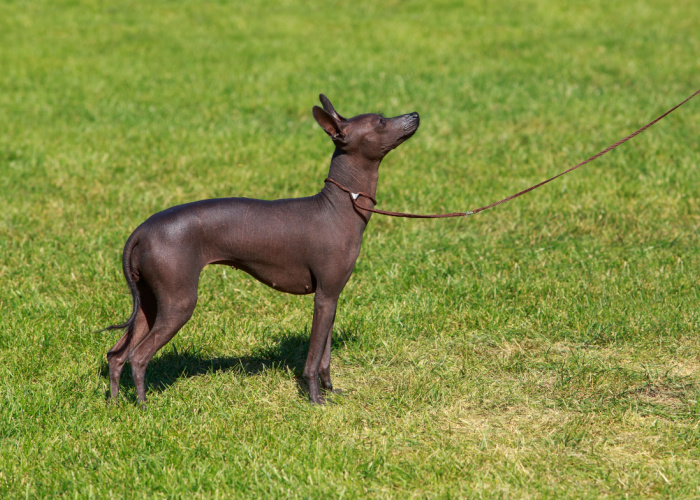
Table of Contents
- Hairless Khala Dog Breed Profile: A Quick Glance
- The Hairless Khala Dog Personality Summary
- Living Conditions and Lifestyle of Hairless Khala Dogs
- 10 Questions to Ask Before Adopting a Hairless Khala Dog
- Are Hairless Khala dogs great family pets?
- Are Hairless Khala dogs great pets for kids?
- Are Hairless Khala dogs great around other pets?
- Do Hairless Khala dogs get cold?
- Do Hairless Khala dogs need baths?
- Can Hairless Khala dogs go in the sun?
- Can Hairless Khala dogs sweat?
- Do Hairless Khala dogs have skin problems?
- Do Hairless Khala dogs have oily skin?
- Do Hairless Khala dogs get fleas?
- The Hairless Khala Dog Breed: Grooming, Diet, and Health
- The Hairless Khala Dog: A Glimpse of the Past
- Before You Go…
Honestly, I’ve never heard of this hairless dog breed before.
Have you?
If not, then this article is for you.
To tell you the truth, I loved writing every bit of information about the Hairless Khala dog!
Wanna know why?
Because according to experts, there’s limited information as to why hairless dogs are born bald.
And writing this just keeps me going and going, digging down the rabbit hole.
It’s believed that this hairless dog comes from one ancestral lineage that originated in the vast mountains of South and Central America.
And if you noticed, this canine breed actually resembles the hairless Egyptian dog, too.
Anyway… to stop me from spilling all the beans at once, let’s go ahead and dive in.
Hold up. This is a comprehensive blog, so you might want to refer to this jump-to guide:
- Physical characteristics
- Personality of the Khala dog
- Living conditions and lifestyle
- FAQs before adopting a Hairless Khala
- Diet, grooming, and health of a Khala dog
- History

Hairless Khala Dog Breed Profile: A Quick Glance
Hairless Khala dogs have so much more to offer other than being popularly recognized for their lack of fluff.
And if you have questions like: “Are Hairless Khala dogs friendly?”
We'll get there in a bit.
What is a Hairless Khala dog?
The Hairless Khala dog is native to Mexico and South and Central America.
This hairless dog breed is believed to have descended from the Incan Empire from the North Andes throughout modern-day Peru, Bolivia, and Ecuador.
The Hairless Khala dog’s ancestors are also located in some parts of the South of Columbia through the Chilean and Argentinean mountains.
Want to get to know more about this hairless Egyptian dog look-a-like?
Take note of the following deets:
| Weigh | 26 – 55 pounds |
| Height | Males: 19 – 26 inches; Females: 19 – 29 inches |
| Lifespan | 10 – 14 years |
| Coat Length | Short |
| Texture & Density | Silky, straight, moderate density |
| Skin Color | Dark gray |
| Pattern | Solid, speckled |
| Suitable for | Mild temperatures (not too hot, not too cold) |
| Suitable Owner Profile | Experienced owners |
| Dog Breed Group | Companion dogs |
| Other Names | Khala Dog
Khala Medio Khala Grande Bolivian Khala Hairless Khala Medio Hairless Khala Grande |
| Recognition | AKAR (American Khala Association Registry)
APRI (American Pet Registry, Inc.) CKC (Continental Kennel Club) DRA (Dog Registry of America, Inc.) |
Did you know: Hairless Khala dogs come in 2 types — the Medio (short-legged) and Grande (long-legged).
Physical Traits of the Hairless Khala Dog
The most prominent feature of the Khala dog is, well, its appearance.
So, let’s take a closer look at this stunningly interesting pooch with the data below:
| Head | Medium in size; mesaticephalic skull type; wedge-shaped with a broad back of the skull that gradually narrows toward the muzzle |
| Eyes | Non-bulging oval to almond in shape with hazel, amber, to dark brown color; |
| Ears | Medium to fairly large in size; slightly elongated and naturally erect by 1 year of age |
| Muzzle | Full and broad muzzle with straight bridge; well-developed upper and lower jaws |
| Nose | well-pigmented according to the coat; well-opened nostrils |
| Neck | Moderately long and powerfully muscled with a slight arch; clean-cut without excess skin or wrinkles |
| Chest | Deep and broad |
| Body | Compact, deep, solid; approximately has equal width with the forequarters and hindquarters |
| Feet | Oval, round, compact with well-arched toes and tough pads |
| Tail | Fairly long tail with a thick base that narrows toward the tip; can appear straight, sickled, sabered, or gently curved |
Did you know: Khala is pronounced “cow-la” which means naked according to the native language of the Quechua Indians.
Characteristics of the Hairless Khala Dog
The Hairless Khala dog is definitely a force to be reckoned with.
When not trained and socialized at an early age, Khalas regard themselves as the leader of the pack.
These distinct beauties need a firm owner that exercises authority in the household.
Otherwise, your hairless furballs will take over your empire in no time.
Besides that, take note of the following characteristics of the Hairless Khala dog for your reference.
| Energy Level | Medium |
| Activity Requirement | Medium |
| Drooling | Low |
| Shedding | Low |
| Affection Towards Owner | Loving |
| Temperament with Kids | Loving |
| Friendliness to Strangers | Low, unless trained and socialized early |
| Compatibility with Other Dogs | Low, unless trained and socialized early |
| Compatibility with Other Pets | Low, unless trained and socialized early |
| Trainability | Easy |
| Barking Tendency | Low |
| Hypoallergenic | No |
Did you know: Hairless Khala dogs were referred to as ‘flower dogs’ by Spanish invaders because they were found sleeping among orchids and other flowers.
Why are Hairless Khala dogs Non-hypoallergenic?
Technically, “no dog is 100% hypoallergenic” according to the American Kennel Club (AKC).
Even low-shedding and hairless dog breeds have dander, which causes allergic reactions in some people.
Not just that, but your dog’s saliva also causes allergies to sensitive hoomans.
However, besides the hairless ones, the most commonly regarded hypoallergenic dog breeds include:
Did you know: Hairless dogs don’t produce all hairless offspring because they have one normal gene and one gene for hairlessness.

The Hairless Khala Dog Personality Summary
| Traits You’ll Love | Traits to Take Note Of |
| Easily trainable | Aloof around strangers |
| Even-tempered | Needs an experienced owner |
| Prefers flight than fight | Sensitivity to extreme temperatures |
| Low barking tendencies | Needs early training and socialization around dogs and other pets |
Did you know: Hairless Khala dogs freeze when they’re startled.
Living Conditions and Lifestyle of Hairless Khala Dogs
Are Hairless Khalas good apartment dogs?
Hairless Khalas can be good apartment dogs due to their medium size and minimal activity requirement.
As companion pups, Khala Medio dogs have a suitable temperament for apartment dwellers, too.
And not to mention their little to no barking tendencies.
However, this hairless dog breed needs daily walks to stimulate its body, as any other canine should.
You can also give your Hairless pups puzzles and interactive dog toys to prevent getting bored.
RELATED: How to Have A Dog In An Apartment: How To Prepare
Can Hairless Khala dogs be left alone?
Hairless Khala dogs shouldn’t be left alone, especially for long periods of time.
Just like any other canine breed, Bolivian Khala dogs can build close relationships with their hoomans.
So when left alone, your Khala dogs can develop separation anxiety.
It’s best to have someone familiar pet-sit your Khalas at home when you’re away for a long time.
Did you know: The Aztecs worshipped hairless dogs as gods and they believed that they would safely guide the souls of the deceased through the underworld.
10 Questions to Ask Before Adopting a Hairless Khala Dog
Are Hairless Khala dogs great family pets?
Hairless Khala dogs make great family pets because of their even temperament and friendliness.
With their affection towards their owners, Bolivian Khala dogs are obedient and, with the right intervention, can be easily trained.
This hairless dog breed’s wariness around strangers makes them great watchdogs, too.
Are Hairless Khala dogs great pets for kids?
Hairless Khala dogs are great pets for kids, thanks to their friendly nature.
However, supervise your children around your Khala Grande dogs and other pets at home to prevent accidents and canine aggression.
Your dog’s tolerance may not match your kid’s energy level, so keep this in mind.
Are Hairless Khala dogs great around other pets?
Hairless Khala dogs aren’t really great around other pets at home.
This hairless dog breed, without proper socialization, can be dominant towards its animal companions.
So, dog owners must exert authority and lead their Khalas just like pack masters.
Do Hairless Khala dogs get cold?
Hairless dog breeds like the Hairless Khala can get cold, especially in extreme temperatures.
Some owners of this hairless breed give sweaters and customized jackets to warm them up.
And without thick coats, Hairless Khala dogs are sensitive to too much heat, too.
So, be sure not to expose your hairless buddies to heat and cold unsupervised.
Do Hairless Khala dogs need baths?
Hairless Khala dogs only need occasional baths depending on dirt exposure and daily activities.
Just make sure to keep your Hairless Khalas clean and tidy to prevent skin problems to which they are vulnerable.
Can Hairless Khala dogs go in the sun?
Hairless Khala dogs can go in the sun and warm up as long as the heat is tolerable.
As native to the warm, tropical climate of the South and Central Americas, Hairless Khala dogs can thrive in humid conditions.
But since they’re hairless, it’s practical to regulate their body temperature to protect your Khala.
Can Hairless Khala dogs sweat?
Hairless Khala dogs only sweat on their paw pads as all canine breeds do.
Despite the contrary belief by some owners, hairless dogs don’t sweat all over their bodies.
When dogs are hot, they typically pant rather than sweat.
To quench their thirst and help prevent dehydration, supply fresh water daily.
Do Hairless Khala dogs have skin problems?
Hairless Khala dogs commonly suffer from skin problems such as squamous cell carcinoma — a type of skin cancer.
Especially when exposed to extreme heat, hairless dog breeds are prone to skin inflammation leading to infections.
To protect your Hairless Khala dogs from skin issues, apply sunscreen on their body when spending time outdoors.
Do Hairless Khala dogs have oily skin?
In general, hairless dog breeds can have various skin types — from oily to very dry.
Partially hairless dog breeds tend to have oily skin while those with little to no hair are very dry.
That’s because hairless dog breeds lack hair follicles that produce oils, which can make their skin itchy.
With this in mind, you’ll need the best itch-control dog products like shampoos, moisturizers, or wipes to prevent further infection from excessive scratching.
Do Hairless Khala dogs get fleas?
Hairless Khala dogs can still get fleas just like any other canine breeds with full coats.
The difference is, you’ll be able to spot those fleas easier because of their lack of hair.
It’s still practical to invest in good-quality anti-flea shampoos for your hairless doggos.

The Hairless Khala Dog Breed: Grooming, Diet, and Health
Grooming a Hairless Khala Dog
| Grooming Essentials | Frequency |
| Bathing | Occasional or depending on exposure to dirt |
| Nail Trimming | 1x per month |
| Ear Cleaning | Weekly |
| Teerth Brushing | Daily |
Note: Hairless Khala dogs can be stubborn when nails are trimmed. Be sure to train them the earliest possible when it comes to grooming sessions.
The Hairless Khala Diet
As a general rule of thumb, feeding your dogs needs to be proportionate to their size.
So, for your Khala dogs at home, be sure not to overfeed them to avoid obesity-related diseases.
And much better: seek your vet’s advice on what type of diet a Khala needs.
Your vets will balance their daily food requirements to the following criteria:
- Weight
- Energy level
- Medical history
Also, be sure to slow down on giving your beloved hairless pooch too much sweet treats.
For a healthier approach, you can give fruit and veggie slices to your Khala dogs occasionally.
The Health of a Hairless Khala Dog
Skin Cancer
Squamous cell carcinoma (SCC), a type of skin cancer, commonly occurs in hairless dog breeds like the Khalas.
White dog breeds are also prone to this skin cancer, affecting their head and abdomen or parts with less hair.
Although unknown, experts from the VCA Animal Hospitals claim that SCC can be caused by a “complex mix of risk factors, some environmental and some genetic or hereditary.”
According to Tufts veterinary dermatologist Lluis Ferrer, DVM, Ph.D., DECVD, hairless dogs can get this cancer anywhere in their body.
If not removed surgically, squamous cell carcinoma can prove deadly over time.
This skin cancer tends to grow very slowly in place, without spreading “but it must be removed so there are no fatal consequences.”
Signs
Watch out for the following symptoms to give you a good glimpse of this skin condition in your Khalas:
- Nail loss in the affected area
- dry, irritated skin or nose lesions
- red, irritated lesions on the toe and nail bed
- A small area of irritated, red, or ulcerated skin
- plaques or crusts that develop over the irritated part
- lesion spreads and gets larger leading to painful sores
Treatment
The “best long-term control” of SCC is surgery according to experts from VCA Animal Hospitals.
…if the tumor can be completely removed, [meaning] no cancer cells are left behind.
Meanwhile, radiation therapy can be done in combination with surgery “if the tumor is not completely removed.”
Prevention
The best prevention is to limit your pup’s exposure to the sun “between the hours of 10 am and 3 pm.”
Especially for hairless dog breeds like the Khalas, you’ll need canine-friendly sunblock to protect against sunburns.
Consult your vet for a proper skin assessment for your hairless doggos.
WATCH OUT: FDA Says Skin Cancer Cream Has Caused Deaths in Dogs
Dental Issues
Canine ectodermal dysplasia is an inherited dental disorder that is common in Hairless Khala dogs.
According to a study, this dental disorder in hairless dog breeds is a:
…result of changes to the genes, microRNAs and signalling pathways involved in dental development.
In other words, the lack of hair in some dog breeds is due to the mutation of a specific gene called forkhead I3 (FOXI3).
While this gene causes hairlessness in dogs, it also affects the development of their teeth.
Because of this mutation, hairless dogs usually have missing replacement teeth (i.e. incisors, canines, and premolars).
What’s more, premolars and permanent molars appear to be differently shaped than coated dogs.
“No specific therapy is necessary” for abnormal dentition in hairless dogs, according to Dr. Brook A. Niemiec, chief of staff of the Veterinary Dental Specialties & Oral Surgery.
But of course, dental hygiene sure counts, isn’t it?
So, daily brushing and regular trips to the vet can contribute to your Hairless Khala’s optimal dental health.
RELATED: Does Pet Insurance Cover Dental Care?
The Hairless Khala Dog: A Glimpse of the Past
| Origin | Central and South America |
| Year | Approximately 2,000 years ago |
| Bred as | Companion dogs |
| Significant deets | Belongs to the same lineage of canine breeds owned by the Incan Empire |
Did you know: Hairless Khala dogs are believed to be the first domesticated dogs in the Americas.
Are Hairless Khala dogs rare?
Hairless Khala dogs are considered to be a rare canine breed.
However, the trend for hairless dog ownership has sparked interest in some people who especially have issues with allergies.
Finding a purebred Hairless Khala from a reputable breeder can take time and effort, though.

Before You Go…
Now, that’s one long, interesting read about the rare Hairless Khala dog.
You probably have noted some things you find attractive about this hairless dog breed, don’t you?
Well, I love how rich the Khala’s origins are.
They’re believed to be the first domesticated dogs in America.
And oh, before I forget, ancient carvings and artifacts of Khala dogs have been found on potteries almost 2,000 years ago.
They were often seen wearing ceremonial dresses, too!
No wonder some say they resemble the hairless Egyptian dog.
What fascinates you about Khalas the most? Let us know in the comments.
Enjoyed reading this blog? You might want to check our top picks below, too.













